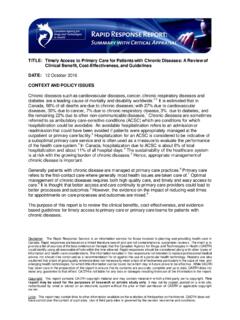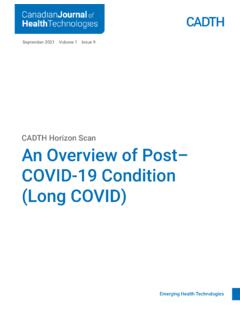Transcription of CEDAC FINAL RECOMMENDATION and REASONS for ... - …
1 Common Drug Review CEDAC Meeting September 17, 2008 Page 1 of 3 Notice of CEDAC FINAL RECOMMENDATION October 16, 2008 2008 CADTH CEDAC FINAL RECOMMENDATION and REASONS for RECOMMENDATION ADALIMUMAB (Humira Abbott Laboratories Ltd.) NEW INDICATION: PSORIASIS Description: Adalimumab is a human monoclonal antibody tumour necrosis factor (TNF). The basis of this resubmission is a new indication. Adalimumab is indicated for the treatment of adult patients with chronic moderate to severe psoriasis who are candidates for systemic therapy. For patients with chronic moderate plaque psoriasis, adalimumab should be used after phototherapy has been shown to be ineffective or inappropriate.
2 Previous CEDAC Recommendations for Adalimumab: Rheumatoid arthritis (see Notice of CEDAC FINAL RECOMMENDATION , February 11, 2005) Psoriatic arthritis (see Notice of CEDAC FINAL RECOMMENDATION , November 29, 2006) Ankylosing spondylitis (see Notice of CEDAC FINAL RECOMMENDATION on Reconsideration, June 27, 2007) Crohn s Disease (see Notice of CEDAC FINAL RECOMMENDATION , December 19, 2007) Dosage Forms: 40 mg in mL solution for subcutaneous injection. The recommended initial dose is 80 mg administered subcutaneously, followed by 40 mg subcutaneously given every other week starting one week after the initial dose.
3 RECOMMENDATION : The Canadian Expert Drug Advisory Committee ( CEDAC ) recommends that adalimumab be listed for patients with severe, debilitating psoriasis who meet all of the following criteria: 1. Body surface area (BSA) involvement of >10% and/or significant involvement of the face, hands, feet or genital region; 2. Failure to respond to, contraindications to, or intolerant of methotrexate and cyclosporine; 3. Failure to respond to, intolerant to, or unable to access phototherapy. Response to adalimumab must be assessed after 16 weeks, and therapy continued only in patients who have responded to therapy. Potential criteria for defining response are achievement of a 75% reduction in Psoriasis Area Severity index (PASI) score, or a 50% reduction in PASI with a 5 point improvement in the dermatology life quality index ( dlqi ) or a significant reduction in BSA involved, with consideration of important regions such as the face, hands, feet or genital region.
4 Ongoing coverage for Common Drug Review CEDAC Meeting September 17, 2008 Page 2 of 3 Notice of CEDAC FINAL RECOMMENDATION October 16, 2008 2008 CADTH adalimumab maintenance therapy should only be provided for responders, as noted above, and for a dose not exceeding 40 mg every two weeks. REASONS for the RECOMMENDATION : 1. Adalimumab achieved statistically significantly higher PASI 75 and PASI 100 response rates compared to placebo and methotrexate, and improved measures of quality of life . One trial included a subgroup analysis of patients who had at least two systemic therapies as well as phototherapy in the prior 12 months.
5 The PASI 75 and PASI 100 response rates were similar in the group that had received recent prior systemic therapies and phototherapy, compared with those who had not received prior systemic therapies and phototherapy. 2. In the largest RCT, patients who did not achieve a PASI 75 response at week 16 (29%) were unlikely to derive benefit after 28 weeks (17%) and 52 weeks (16%) of therapy. 3. At recommended maintenance doses, the annual cost of adalimumab ($18,191) is lower than efalizumab ($21,420), which was previously recommended for listing by the Committee. Summary of Committee Considerations: The Committee considered a systematic review of three double-blind randomized controlled trials (N=1232), evaluating the effects of adalimumab in adult patients with moderate to severe plaque psoriasis or active psoriasis despite receiving topical therapies.
6 The number of patients who achieved a 75% reduction in the PASI score was the primary outcome for all three trials. The primary endpoint was measured after 12 or 16 weeks of therapy. One trial enrolled patients who were na ve to anti-TNF agents. The second trial compared adalimumab to placebo and included 150 patients who had previously used a biologic therapy. The third trial compared adalimumab to methotrexate and placebo in patients who had not previously used anti-TNF agents or methotrexate. Adalimumab was associated with statistically significant improvements in PASI 75 and PASI 100 response rates, dlqi , Patient s Global Assessment, and Physician s Global Assessment, compared with placebo.
7 The number needed to treat (NNT) to achieve a PASI 75 response was approximately 2 after 12-16 weeks, compared with placebo. Adalimumab was also associated with statistically significant improvements in PASI 75 response rates compared with methotrexate in patients na ve to anti-TNF agents and methotrexate. Extension trial data that included unblinded treatment periods suggested that patients who do not achieve a response by week 16 are unlikely to benefit from continued therapy with adalimumab. These data also suggested that the rate of response decreases over time, but that adalimumab is able to maintain response better than placebo between 33 and 52 weeks of therapy.
8 The duration of the double blind phases of the trials were too short to assess the relative risk of serious harms. The product monograph for adalimumab highlights the potential for serious adverse events, such as infections and malignancies, which are concerns with the use of all anti-TNF agents. Recent post-marketing surveillance data in patients taking adalimumab have confirmed the need for vigilant monitoring of patients for signs and symptoms of infectious complications. The manufacturer submitted a cost-utility analysis comparing adalimumab to other treatments (methotrexate, cyclosporine, etanercept, efalizumab, alefacept, infliximab) in moderate-severe psoriasis.
9 Given the lack of comparative clinical data between the biologic agents, and the positioning of adalimumab after failure to cyclosporine ($4,108-$6,193 yearly) and methotrexate ($324 yearly), the Committee felt that a cost comparison with available biologic agents was the most valid comparison at Common Drug Review CEDAC Meeting September 17, 2008 Page 3 of 3 Notice of CEDAC FINAL RECOMMENDATION October 16, 2008 2008 CADTH this time. At recommended maintenance doses, the annual cost of adalimumab ($18,191) is lower than etanercept ($20,377), efalizumab ($21,420), infliximab ($25,220) and alefacept ($29,976).
10 Of Note: 1. Both published and unpublished data were reviewed and taken into consideration in making this RECOMMENDATION . 2. The Committee reviewed ongoing reports of serious safety concerns involving anti-TNF agents. There is a need for careful consideration of the balance of possible benefits and harms, particularly given the risks of developing infections and malignancies from the use of these agents. 3. Given the high cost of biologic agents, expansion of phototherapy access into geographical areas where it is currently unavailable should be considered. Background: CEDAC provides formulary listing recommendations to publicly funded drug plans.








